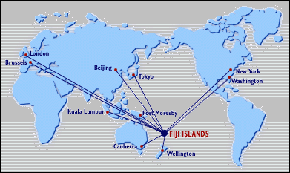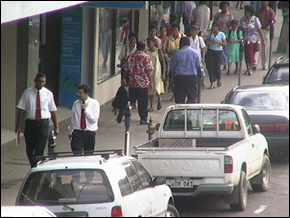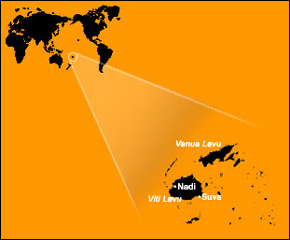 POSITIONED
FOR MORE TRADE POSITIONED
FOR MORE TRADE |

Fiji has secured bilateral trade agreement (BTA)
with its Pacific island neighbours, beginning
with the signing of a non-reciprocal trade agreement
with Tonga in 1995. It has BTA too with Tuvalu,
Cook Islands, Papua New Guinea, Vanuatu, Solomon
Islands, New Caledonia, Kiribati, Nauru and Samoa.
Since 1993, a free trade agreement for members
of the Melanesian Spearhead Group (MSG) that includes
Papua New Guinea, Solomon Islands and Vanuatu
came into being. Fiji joined the trade pact in
April 1998. MSG members can do trade in 200 products
free of fiscal duty, with Fiji and PNG poised
to benefit the most given their relatively developed
manufacturing sectors.
Fiji is also expected to be a key player in PACER,
the Pacific Agreement on Closer Economic Relations
(PACER) and the Pacific Islands Trade Agreement
(PICTA) that will come into force soon now that
they have been ratified by six member countries.
PICTA promotes free trade between 14 Forum island
countries including Fiji, whilst PACER includes
all 14 plus Australia and New Zealand. Says Noel
Levi, Secretary-General of the Pacific Islands
Forum Secretariat, that overseas PICTA and PACER:
"We believe that expanding our trade will
bring economic and social benefits to help improve
our standard of living". The Secretariat
will work alongside Forum members and development
partners to minimise any negative effects and
adjustment costs. "Pacific Closer Economic
Relations (PACER) provides a framework for strengthening
trade and economic cooperation among all Forum
members at an appropriate 'pace,' reflecting the
differing development status of the matters",
explains an FTIB
trade brochure. "Under PACER framework,
the Pacific Island Countries Trade Agreement (PICTA)
provides for the establishment of a free trade
area among the 14 Forum Island Countries".
PICTA will be phased in over a decade, explains
the brochure, and aims to create employment and
other economic benefits through increased trade
and investment opportunities in a large common
market.

|
That Fiji is poised
to benefit a lot from PACER and PICTA is due to
a large measure to opportunities currently offered
by SPARTECA, the South Pacific Regional Trade and
Economic Cooperation Agreement, between Fiji and
other members of the Pacific Islands Forum on the
one hand and Australia and New Zealand on the other.
Signed in 1981, SPARTECA allows duty free access
of goods for members of the Forum to Australia and
New Zealand, subject to "rules of origin"
regulations. To redress the unequal trade relationships
between the two groups is a major aim of SPARTECA
and a major beneficiary has been the island countries'
textiles, clothing and footwear industry. Facilitating
this to a large extent was the introduction by Australia
in 1991 of its Import Credit Scheme (ICS) as part
of a larger package of tariff and other industrial
reforms in that country. However, due to World Trade
Organisation rules, the SPARTECA TCF Provisions
Scheme was arranged to succeed ICS. TCF provisions
scheme complements the existing SPARTECA treaty
and provides for a change in the way local area
content (LAC) is calculated for TCF products entering
Australia from Forum Island Countries.

 From the
Heart of the Pacific to the World From the
Heart of the Pacific to the World |

Says Foreign Minister Tavola:
"Of added interest to investors also are
our linkages with other markets, our trade agreements
through SPARTECA with Australia and New Zealand
and through the GSP with the US. Fiji is not only
a local market but instead it is also the heart
of the all the Pacific markets. From Fiji you have
access to all the Pacific Island countries. With
all these trade agreements we are going to give
a new dimension to trade, we will expand trade as
we are the hub of the Pacific". Bilaterally,
Fiji entered into a trade agreement with Australia
under FATERA, the Fiji-Australia Trade & Economic
Cooperation Agreement, signed on March 11 1999.
FATERA is important for Fiji given that 60% of its
total trade is with Australia. The island country
had also entered into similar BTA with New Zealand,
USA and China. For the US, Fiji's garment exports
enter through a quota system while for China, Fiji's
exports is offered MFN treatment. Trade
Minister Vuetilovoni says Fiji is also seeking
further preferential access of its exports into
the US. "We are trying to obtain similar
concessions, the US Government extends to African
countries and that is, duty free and quota free.
This of course will require intense lobbying efforts
and which we may not be able to afford".
As a member of the African, Caribbean and Pacific
bloc of nations, Fiji's goods enjoy preferential
access into the European Union. However, in light
of WTO rules and in keeping with the terms of the
Cotonou Agreement signed between the EU and the
ACP, Fiji will have to negotiate a reciprocal trade
agreement with the EU by 31 December 2007 at the
latest. |

